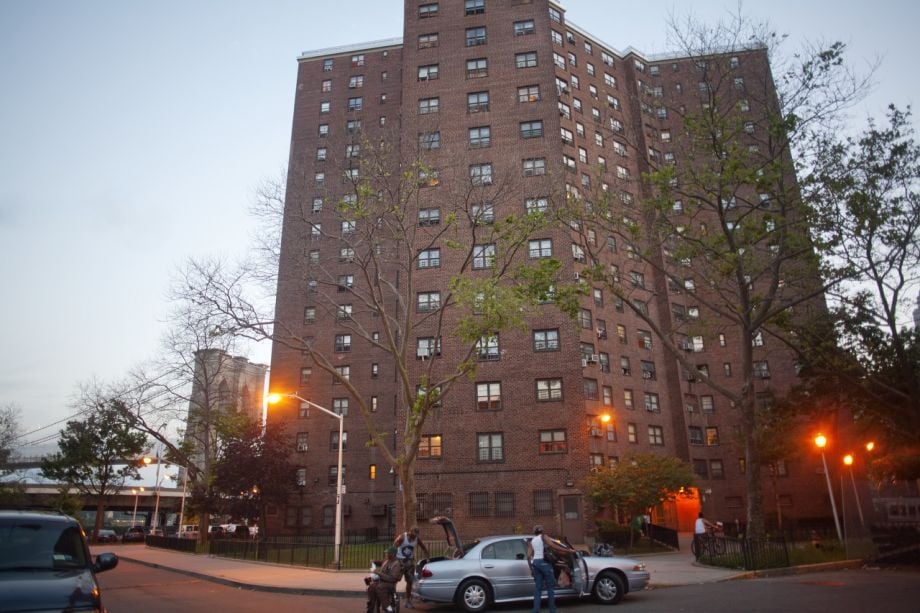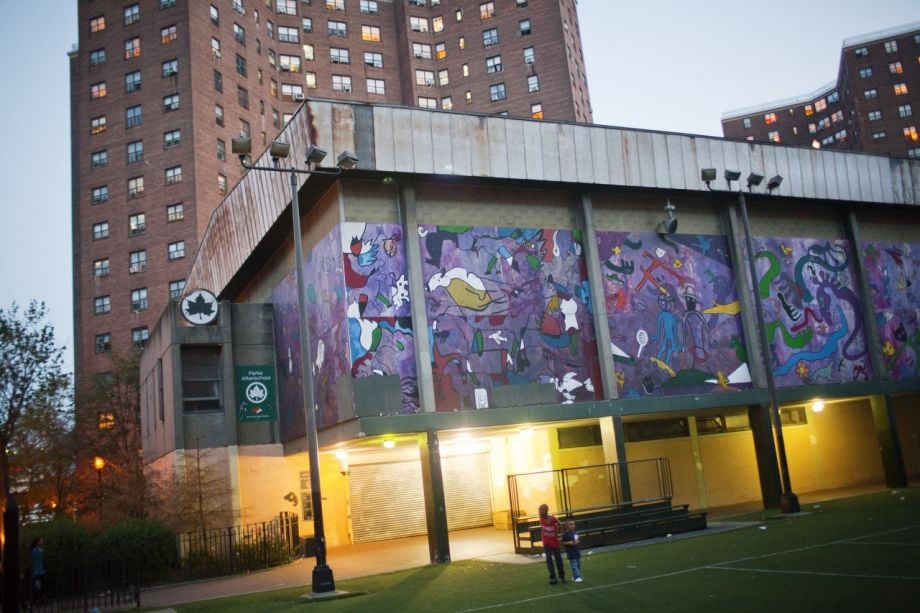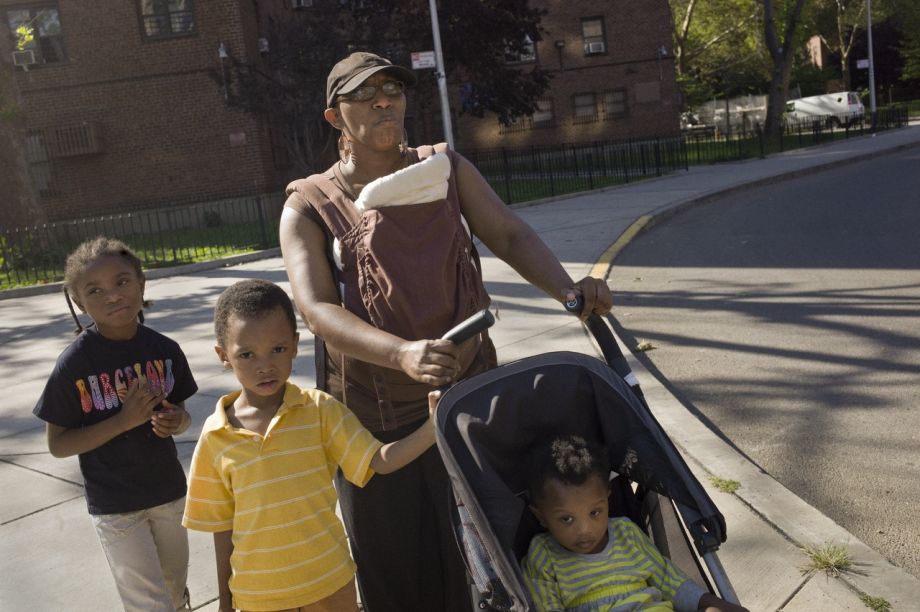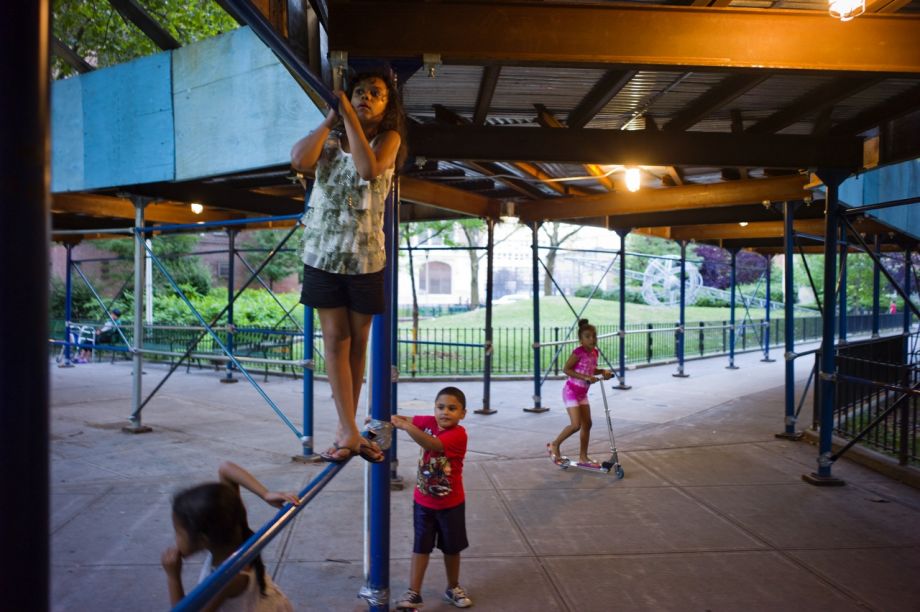Are You A Vanguard? Applications Now Open
This is your first of three free stories this month. Become a free or sustaining member to read unlimited articles, webinars and ebooks.
Become A MemberThe Alfred E. Smith Houses on Manhattan’s Lower East Side are not the squalid, frightening badlands you probably think of when you hear the phrase “housing project.” Sure, they follow the ungainly Corbusian model of towers-in-a-park. And if you venture onto the stairway in one of the apartment buildings, the stench of urine is overpowering. But the image you might have — of isolated high-rises surrounded by vast, empty swaths of concrete, with no one but menacing drug dealers sitting on broken benches — is not how the area feels.
Rather, the little patches of space created by the buildings’ odd angles are verdant, with healthy grass and trees providing shade. There are basketball courts that double as a baseball diamond. On the western border, facing the street, stores and a diner occupy the ground floors. Many of the residents are solidly middle class: Public housing tenants in New York are allowed to have incomes as high as $68,700 per year for a family of four. And given the city’s astronomical market-rate rents, many civil servants and blue-collar workers are happy to live here.
Walking around the Smith Houses on a weekday afternoon feels perfectly safe. The ample sunlight and open space makes it apparent just what those misguided mid-century architects were thinking when they designed projects like this all over the country. Even the demographics — largely black and Latino but, since it’s just east of Chinatown, a large Asian contingent as well — are unusually diverse. Perhaps most notable, since the Smith Houses sit right next to the East River, are the grand views of the Brooklyn Bridge, immediately to the south.
Those views will not remain for long. In February, the New York City Housing Authority (NYCHA) announced a plan to lease space in the footprint of eight Manhattan housing projects to real estate developers. The developers will put up market-rate housing, with 20 percent set aside as affordable. (Typically, New York buildings adopt this 80/20 split in exchange for participating in a state-financing program. In this case, it will be mandated.) Five of those projects are in Alphabet City or on the Lower East Side, including the Smith Houses, where the land being taken is a parking lot on the area’s eastern border. The new high-rises would thus block — or, some might say, steal — the views of some current residents.
The plan has become a symbol for something larger: The way New York, especially under Bloomberg, seems to be inhospitable to anyone but the wealthy.
The NYCHA infill plan is part of a radical experiment: Putting market-rate housing in the projects. For the last half-century, the word “projects” has become to many Americans almost a synonym for urban poverty and crime. The inherent unpleasantness and undesirability of being anywhere near them was considered self-evident. Richard Nixon and George Romney, his Housing and Urban Development (HUD) secretary, began the process of replacing federal programs to build low-income housing with voucher programs, a trend that has continued ever since.
But while other cities rethink public housing, New York has found itself constantly overwhelmed by a huge demand to live in its projects. (There are approximately 160,000 families on the waiting list.) Crime in New York has continued its extraordinary 20-year decline: In the first half of this year there were only 154 murders in New York and 417 in all of 2012, compared to a peak of 2,605 in 1990. No one thinks the projects are so dysfunctional or dangerous that they should be abandoned. The gap between demand and supply of housing in or near Manhattan — and the absence of fear of crime — has pushed gentrification into areas from Washington Heights to Bushwick that for so long had been invisible to the affluent. Well-heeled professionals now routinely spend millions of dollars on homes directly across the street from the projects. Moving in literally next door would seem to be the next logical step.
Meanwhile, aging buildings and declining investments at the federal and state level have left NYCHA with serious financial shortfalls, both near and long term. As City Limits reports, “The New York City Housing Authority is in dire financial straits, facing a yearly deficit of about $40 million in operating costs, as well as a $6.6 billion deficit in capital needs, such as repairs to roofs, elevators, heating and grounds. While residents pay 30 percent of their wages towards rent, the bulk of NYCHA’s funding comes from the government, which has radically scaled back its support of public housing: In 2001, capital funding was around $420 million, and 99 percent of NYCHA’s operating costs, but in 2011, it was down to only $270 million, and only 89 percent.”
In short, NYCHA needs money. The asset it has to sell or lease, thanks to that towers-in-a-park design, is excess land. Leasing these spaces is projected to generate $32 million per year, which would be invested in repairs. And so, according to Mayor Michael Bloomberg, NYCHA and their defenders, leasing land to private developers is a win-win. NYCHA and its residents get money for repairs and the city gets much-needed housing stock.
“As money from HUD and other agencies dries up, it’s more important than ever to think creatively about how to finance the needed improvements to public housing,” writes Majora Carter, founder of Sustainable South Bronx, an environmental and economic justice advocacy organization, in an email. “The real estate landscape has changed dramatically in American cities over the past 30-50 years, when much of this housing was built. At that time, no one could imagine the re-urbanization that is taking place all over, and especially in parts of New York City… Manhattan real estate is a resource.”
Even affordable housing advocates, not a group known for favoring private developers, are often cautiously supportive of the plan. “The move to lease higher value sites seems like a no-brainer,” says Rosanne Haggerty, president of Community Solutions, which provides social services to combat homelessness. “NYCHA needs resources to exist as a functioning agency that can pay its bills.”
New York also needs housing at every level, not just the lower-income end. As of June, the median rent in Manhattan was $3,195 per month, up 6.7 percent from the same time last year, and the vacancy rate is at a two-year low of 1.46 percent. “We’re in a housing crisis in New York City — and we have been for decades — in which vacancy rate for residential properties is extremely low,” says Matthew Dunbar, associate director for government relations and advocacy at Habitat for Humanity, New York City. “The underlying cause of unaffordability is the lack of vacant units. This proposal is targeted in Manhattan where the vacancy rate is lower than the other boroughs. There is very little land available for development, especially in Manhattan. Density and density bonusing is good from our perspective.”
So why are NYCHA residents unhappy about it? Well, there are the interrupted views. But plenty of people with no view are also protesting. Angry residents have flooded public hearings and complained to the City Council. At a City Council Committee on Public Housing hearing in April, the New York Times reported, “tenant-association presidents from at least four of the eight sites that have been selected for development expressed concerns about the plan — and in the case of Smith Houses, Meltzer Houses and Baruch Houses, outright rejected it.”

The NYCHA infill plan is part of a radical experiment: Putting market-rate housing in the projects.
No one likes major construction next door, and no one wants to lose a parking space or basketball court. But it’s clear that the residents are angry with far more than that. The plan has become a symbol for something larger: The way New York, especially under Bloomberg, seems to be inhospitable to anyone but the wealthy. After years of strained relations with NYCHA, deferred maintenance on buildings, and gentrification and displacement going on around them, residents feel a visceral sense that any scheme will fail to take their needs into account. Indeed, they wonder if it may even be a first step toward kicking them out of the city altogether.
“The residents’ sentiment has to do with the idea that they have no rights, and that their lives will be disrupted for years to come and the people to benefit will be higher-income people,” says Susan Saegert, a professor of environmental psychology at the CUNY Graduate Center.
“The [insertion of] market-rate housing is unacceptable,” councilmember Margaret Chin, who represents affected projects in downtown Manhattan, flatly declares. “Public land should be used to build more affordable housing.” New York City’s Democratic mayoral candidates have also criticized the infill plan. “We should not be using it for luxury housing,” said former New York City comptroller Bill Thompson at an April forum. “We should be using it for affordable housing, workforce housing, moderate and middle-income housing, so that those who live in the City of New York can afford to stay here.” City Council Speaker and current mayoral front runner Christine Quinn said, “The plan to auction off NYCHA housing to the highest developer to build in essence luxury housing is a terrible idea. It is an idea that doesn’t come from community input, that isn’t going to help deal with the affordable housing crisis that exists in our city.”
That’s especially noteworthy because Quinn and Thompson are both seen as industry friendly, and Quinn is frequently allied with Bloomberg. Some housing advocates dismiss these statements as pandering — current residents in the affected projects may be strongly opposed to the plan, while it is impossible for theoretical future residents to be as strongly in favor. But complaining about the plan’s shortcomings does not put money in NYCHA’s budget.
“Give me ideas to secure the future of public housing that don’t involve grown-up tradeoffs,” Haggerty scoffs. “People running for office say, ‘I’m with the people.’ But it’s just irresponsible to be whipping people up with no answer as to how to plug billions of dollars of projected revenue gaps.”
Much of the criticism, from residents and advocates, pertains to process. They say that NYCHA has tried to rush this through without giving residents adequate information and time to review it. To some, this is just another instance of two long-standing New York practices: Developers — and an administration in bed with the real estate industry — pushing for luxury towers on every conceivable patch of land, and NYCHA ignoring and disempowering its residents.
“The issue is the way it was put together and presented to residents and to elected officials without enough meaningful input from residents,” Chin says. “Do we really need more market-rate housing? I don’t think so. How many market-rate housing [developments] have gone up in my district? The real issue is the waiting list for public housing. We need to use precious resources, our land, for more affordable housing.”
“All of a sudden, the housing authority in the waning days of the [Bloomberg] administration comes up with a giant plan without consultation with the residents themselves or neighboring communities,” says Tom Angotti, a professor of urban affairs and planning at Hunter College. “The reaction from residents has been pretty clear: They want a say in what happens on their land.”
“[The opposition] comes from NYCHA being hard to work with on resident uses of the empty spaces,” Saegert says. “I worked 20 years ago with a residents’ alliance on a scheme to develop markets on weekends, where people could sell food and braid hair and craft products and things like that. We worked for two or three years and NYCHA told them they had no rights to use the space. That kind of relationship between the Housing Authority and residents does not make them open to wholesale appropriation for high-income residents, which I think is psychologically understandable.”
“People running for office say, ‘I’m with the people.’ But it’s just irresponsible to be whipping people up with no answer as to how to plug billions of dollars of projected revenue gaps.”
Aside from process, there are two other major complaints: The new constructions do not meet the city’s, or the NYCHA residents’, social needs, and that the plan is not even financially necessary. Making the former point, Angotti says, “There’s absolutely no reason why the city should be taking away recreational areas and open space to build new housing, especially in Manhattan that has so little open space, and especially to serve communities with large young populations.” But many housing policy experts argue that excessive open space is actually a design flaw, and that meeting the city’s housing shortage is as good a reason as any.
The financial argument is relatively straightforward. Due to a 1994 agreement, NYCHA pays the city more than $70 million per year to police common areas such as stairwells. Every other private landlord in the city gets those policing services for free once they sign on to a NYPD program known as “Operation Clean Halls.” NYCHA also gives the city $23 million annually in “payments in lieu of taxes.” In essence, that’s its property tax bill. So, NYCHA residents say, why can’t NYCHA get its money by eliminating these payments instead of inconveniencing them with the infill plan?
“[Public housing tenants] want safety and security and they think they’re entitled to it like any other residents as a result of their taxes,” says Victor Bach, senior housing policy analyst at the Community Service Society of New York. “We’re calling on all of the mayoral candidates on Day 1 to terminate these payments.” At the April forum, all the Democratic candidates — there were no Republicans in attendance and Anthony Weiner was not yet in the race — pledged to do so.
But in addition to the fact that its capital investment gap would still be a problem, a savvy mayor could eliminate these payments and replace those funds with other cuts from NYCHA. “Any mayor would have to replace that money from somewhere else, and would likely to take it away from NYCHA,” says Julia Vitullo-Martin, director of the Center for Urban Innovation at the Regional Plan Association. “I think [the Office of Management and Budget], one of the most powerful and aggressive mayoral agencies, is going to find a way of replacing that money without taking it from other programs or raising taxes. That’s what budgetary politics is about. No mayor is going to want to increase subsidies any place that isn’t completely necessary.”
Many progressive housing advocates actually see developing the land as a good thing on its own terms. The towers-in-a-park model, which became popular after World War II, is at best a waste of space, and at worst an enormous social and aesthetic failure. The decimation of street life through the destruction of a street grid and imposition of superblocks, and the isolation of the poor in hard-to-police vertical towers, are two main drawbacks, blamed for high crime rates and low quality-of-life for residents. The buildings are also ugly, monotonous and seemingly never-ending shafts of brown concrete and maroon brick that project outwards, rather than welcoming inwards, at harsh geometric angles.
“Jane Jacobs used the term ‘self-isolating projects,’” Vitullo-Martin says. “It’s an accurate term for the relationship between many NYCHA projects and their neighborhoods.”
Even in the Smith Houses, where the little green spaces are pleasant, it can hardly be described as a model of efficient land use or good urbanism. Yes, the parking lot serves tenants, but Manhattan is simply too dense, and land holds too high a premium, to throw it away on publicly subsidized surface parking lots. At the Smith Houses, there are 110 spaces and NYCHA charges the typical resident with a permit — for which there is a waiting list, of course — $340 per year. That’s less than many Manhattanites pay for parking each month.
Some community members, such as Chin, argue that NYCHA residents who need to drive to work should deserve parking spots. But the city is full of people who need a car and don’t get a publicly subsidized space. On the free market, parking is only economical in Lower Manhattan when built into a multi-tiered garage and charging a much higher rate. Manhattan’s land is much too valuable to be so wasted. (Smith Houses tenants note that before that space was made a parking lot, roughly 10 years ago, it was park space.)

Given Manhattan’s astronomical market-rate rents, many civil servants and blue-collar workers are happy to live in public housing.
The dominant center-left thinking on public housing for the last 20 years has had two main components: Projects should be small-scale, physically integrated with the community and mimic middle-class housing in their aesthetic and even financial arrangements, and that the poor should live among the better-off. Low-income housing usually goes neglected during Republican presidential administrations, but the last two Democratic presidents have created federal programs to move public housing in this direction. Bill Clinton sought to disperse and integrate the poor throughout cities, while President Obama has tried, through the Choice Neighborhoods program and the Partnership for Sustainable Communities, to incentivize the development of safe, mixed-income, transit-accessible neighborhoods instead of just throwing up low-rent high-rises with their backs to the street.
Even opponents of the NYCHA infill plan tend to grant that these would be a better approach to building new projects, but they note that merely sticking new luxury towers in the empty spaces is no substitute for good urban planning. Just squeezing more buildings into these superblocks, rather than reconnecting the street grid and mimicking the mixed-use urbanism of desirable New York neighborhoods, does not necessarily improve aesthetics or quality of life at all. “You’re still going to have these towers, and you’re not going to have the outdoor space that was supposed to compensate for lack of indoor communal space,” Saegert says. “I’m not a big defender of towers-in-a-park as a successful theory, but I’m not sure that towers-not-in-a-park is better.”
Clinton’s HOPE VI program tore down infamously blighted projects like Chicago’s Cabrini Green. It sought to create lower-density, dispersed public housing that would be part of socioeconomically integrated neighborhoods. NYCHA says it is pursuing that goal, but not by tearing down its housing. New York is in the enviable position of having rich people who actually want to live next to the projects, so why not let them do so?
“The Bloomberg administration does not have a record of keeping the value for the public good, instead of giving the store away to developers.”
And so, those who subscribe to the new mainstream liberal consensus tend to see the infiltration of NYCHA projects with expensive market-rate buildings as a feature, not a bug, in the proposal’s design. “I think whatever housing is put there, if it integrates the neighborhood, if it gives a larger range of incomes within the housing authority properties as well as increasing the density, that’s a good thing,” says Theodore Liebman, a principal at Perkins Eastman and former chief of architecture for the New York State Urban Development Corporation.
“Concentrated poverty exacerbates negative health, educational and other social outcomes,” Carter notes. “The impact on young people who see examples of success in their lives is priceless. Likewise, it’s always better when more successful people can interact with those who are often portrayed in the media as a ‘problem.’ When we can see each other more fully, we make better decisions about our own lives, and the direction of our shared, built environments.”
But now that Hope VI has been around long enough for its success to be measured, it turns out that economic integration is no panacea. Major studies, such as a 2001 report by the Urban Institute, have found that residents of HOPE VI projects continued to experience high levels of crime and no improvement in their employment outcomes. In fact, some experts say HOPE VI often had unintended negative consequences for residents of public housing.
“There’s been a huge increase in the stigma public housing residents experience and harassment by police,” Saegert says. “[HOPE VI residents] get threatened with eviction if their children get into fights with higher-income children.” If you put a bunch of rich people next door to the projects, the city will police the projects more aggressively. Rather than an integrated community you could get two mutually suspicious enclaves, one of which has more economic, and therefore political, power than the other. The conflict recently came into the public eye when a real estate developer on the Upper West Side proposed separate entrances for market-rate and affordable-tenants in a mixed-income development, inciting outrage when the story went viral with headlines about a “poor door.”
And anyone who claims the new market-rate residents will be eager to get to know their neighbors in the projects is probably being overly optimistic. NYCHA is caught between a rock and a hard place: in order to mollify tenants’ fears that they will be displaced or imposed upon, NYCHA has made sure that no one will be required to move out of their home, even temporarily. But that prevents NYCHA from significantly improving the projects aesthetically or integrating the buildings economically.
“What if [NYCHA chairman] John Rhea had said, ‘OK, we really believe in social and economic integration, so we’re going to take everyone out of [the Frederick Douglass Houses, an Upper West Side project that is part of NYCHA’s infill plan] and do a magnificent job renovating, and put everyone back and scatter them by race and income,’” Vitullo-Martin says. “Can you imagine the uproar? People would have been outraged if you moved people around from their current buildings. He didn’t have that option, and the advocates would have been beside themselves.”
Likewise, efforts to reassure NYCHA tenants that they won’t face competition from the newcomers for commercial or social services can instead reinforce fears that market-rate tenants will be a self-contained alien presence. “The [new building] would have its own laundry rooms and everything, so it would be a separate community,” says Monique Harris, secretary of the Smith Houses tenant association. “It feels like segregation, because NYCHA says, ‘There won’t be any need [for new residents] to venture into your community.’”

“This city has become the tale of two cities: The rich and the poor, and because we’re poor we can’t live here,” says Aixa Torres, a civil servant and president of the tenant association at the Smith Houses, where she lives with her family.
NYCHA insists, though, that HOPE VI is not a good predictor of whether its infill project will succeed. “The failure of HOPE VI is one of our inspirations,” says Fred Harris, NYCHA’s executive vice president for development (no relation to Monique). “It lowered the overall density and decreased dramatically the proportion of low-income residents. De-concentrating poverty is a good thing, but maybe the mix they introduced was below a critical mass. We are increasing density and adding economic diversity within new market rate and low-income apartments. Here the number of low-income people is actually going to go up, because there are going to be some in the new buildings as well.”
That is, if the 80/20 buildings actually include 20 percent low-income residents. Leftier critics of the general pro-market and pro-real estate industry tilt of the Bloomberg administration say that the 80 percent market/20 percent affordable concept has too low a proportion of affordable units. They also argue that the income threshold for the affordable 20 percent is set too high, and thus the buildings end up looking more like 80 percent rich and 20 percent middle class. The standard is usually 50 percent of the Area Median Income, a number based on the entire metropolitan region. Since New York is a high-income area, that works out to $42,950 for family of four.
“In our 80-20s, the 20 is going to be different,” Fred Harris says. “We’re not going to permit developers to skid under the bar and qualify.” In many buildings, developers cherry pick applicants who fall just below the qualifying income threshold for their 20 percent affordable component. Harris promises that NYCHA won’t allow that. Instead, it will require that the affordable component serve a wider economic cross-section, and half of the residents of the affordable units will come from the neighboring projects, so the two communities will be better integrated. (The affordable and market-rate tenants within the new buildings themselves will be interspersed on the same floors, according to NYCHA, and all amenities will be open to all residents regardless of what they pay.)
NYCHA even hopes that this will help solve one of its nagging problems: that when children grow up and move out, elderly residents stay in their two- and three-bedroom apartments with empty rooms while large families languish on the waiting list. Says Harris, “We’d love to see over-housed seniors move into a smaller apartment in a brand new building to open up bigger apartment for a family that needs it.”
But 80/20 buildings create another problem: They are a microcosm of New York’s trend towards being only the rich and poor, with the middle class squeezed out between the extravagant cost of market-rate housing but too well-paid for the select few affordable units. “I, because of my income, would not be able to participate [in the new low-income housing],” says Aixa Torres, a civil servant and president of the Smith Houses tenant association. “I’m over the income, and I can’t afford the market rate because I don’t make six figures.”
At its root, political opposition to the NYCHA infill plan is an expression of the city’s underlying conflict over gentrification. For years, when crime was high and the streets and subways were dirty, Manhattan’s low-income residents lived and worked in the city and struggled to bring it back from the brink of a Detroit-like downfall. “You want the real estate because you think poor people have no right to live near the East River?” Torres demands rhetorically. “When nobody wanted to live next to the water, we did and we continued to maintain this community.”
Today wealthier newcomers arrive in droves, turning every storefront into an unaffordable outlet for twee $35 baby shirts or $4 cups of coffee. “Delancey Street is changing, every block there’s 12 lounges and bakeries, it’s all high-end,” says Monique Harris. “There are no more mom-and-pop shops.” Since the nearby Pathmark closed, there is no large supermarket nearby, causing problems for disabled elderly residents.

Children at the Smith Houses find play areas in whatever open space is available.
Blocking the infill plan would, of course, not stop gentrification. Indeed, one might argue it would exacerbate it, as constraining the supply of market-rate housing causes prices to increase. The fundamental reason that rich people push ever further uptown and into the outer boroughs is the mismatch between supply and demand in New York’s central neighborhoods. As pro-density economists and economic writers such as Harvard’s Ed Glaeser, Slate’s Matthew Yglesias and The Economist’s Ryan Avent argue, neighborhoods like the West Village are outrageously expensive because it is illegal to build taller buildings there. Allowing the development of tall buildings can cause prices to rise slower, as it has on the Upper East Side east of Lexington Avenue. But if you live in a project on Upper West or Lower East Side, you are already surrounded by gentrification. Putting a luxury high rise next door brings it that much closer, that much more in your face, and puts that much more pressure on commercial landlords to jack up the rent and replace the few remaining bodegas with bakeries peddling expensive croissants.
The city, especially under Bloomberg, seems to think that is a good thing, eagerly facilitating, through upzonings and other building incentives, the replacement of longstanding communities and businesses in areas like Downtown Brooklyn and Williamsburg with luxury housing towers and upscale chain stores. So there is an instinctive reaction for NYCHA residents to worry that they will be further marginalized — as they already have been in their own neighborhood — on their very own block. City Comptroller John Liu, another mayoral candidate, says that the infill plan is similar to upzonings in Brooklyn and will yield a similar crop of lookalike luxury buildings that benefit developers while displacing existing populations,
“The Bloomberg administration does not have a record of keeping the value for the public good, instead of giving the store away to developers,” Liu says. “They rezoned so much of the city and unlocked so much value out of thin air. In almost all cases, the people who profited handsomely were people who owned the property or were developing property. Very little public good came out of rezoning. NYCHA’s infill plan is not that different from the give-away of air rights.”
Moreover, residents worry that this may actually be a first step toward eliminating or privatizing the projects themselves. After all, if first rich people move across the street, then into the project footprint, why not take the very land that the projects now sit on? From the perspective of beleaguered residents, it’s the natural endpoint for Bloomberg’s New York.
“This city has become the tale of two cities: The rich and the poor, and because we’re poor we can’t live here,” Torres says, echoing a common phrase uttered in the mayoral campaign. “The same thing that happened in Harlem with people who put in sweat equity with brownstones, but can’t stay there because of the property taxes, will happen to us.”
The whole kerfuffle can seem strange to an outside observer: Most cities should be so lucky as to have these problems. “In many cities you wouldn’t find developers interested in building in the midst of public housing,” observes Ed Goetz, a housing policy professor at the University of Minnesota. “It speaks to the extreme nature of housing market in New York City, how difficult it is to find land.” In other cities, lack of funds and social problems attendant to isolated poverty has forced them to abandon public housing altogether.
By contrast, New York has the opportunity to prop up its public housing financially and connect it to market-rate housing physically. To most policy analysts, high demand for housing is an asset that clearly should be harnessed in some way to protect public housing, rather than sitting idly by and watching its demise. As Goetz points out, “Some housing authorities have actually sold off units in order to close short term budgetary deficits and meet maintenance and other operating cost obligations, and that is obviously an even less preferred option.”
Especially interesting about New York’s situation is that it may be replicated in other cities in the future. New York was, after all, one of the first cities to experience the gentrification that has made NYCHA’s infill plan feasible. NYCHA readily admits that if the plan works out, projects adjacent to other trendy areas, such as Boerum Hill, DUMBO and Long Island City, may soon get some rich next-door neighbors as well.
As with so many urban phenomena, including gentrification itself, the rest of America follows New York’s lead. Virtually every major city now has a downtown yuppie population, and some once notoriously troubled and downtrodden cities, like Washington, D.C., have seen modest row houses in former slums swiftly turn into expensive homes for young professionals. Crime is often still more of a concern elsewhere than it is in New York, but it is everywhere far less of a concern than it was in 1990. Maybe other public housing authorities will soon contemplate a plan like NYCHA’s. And they will also find that opportunity and loss can live in the same footprint.
Forefront is made possible with the generous support of the Ford Foundation.
Our features are made possible with generous support from The Ford Foundation.

Ben Adler is a journalist in New York. He is a former reporter for Grist, The Nation, Newsweek and Politico, and he has written for The New York Times, The Atlantic, The Guardian and The New Republic.

Alan Chin was born and raised in New York City’s Chinatown. Since 1996, he has worked in China, the former Yugoslavia, Afghanistan, Iraq and Central Asia. Domestically, Alan has followed the historic trail of the Civil Rights movement, documented the aftermath of Hurricane Katrina and covered the 2008 presidential campaign. He is a contributing photographer to Newsweek, the New York Times and BagNews, an editor and photographer at Newsmotion and a photographer at Facing Change: Documenting America (FCDA). Alan’s work is in the collection of the Museum of Modern Art.

20th Anniversary Solutions of the Year magazine